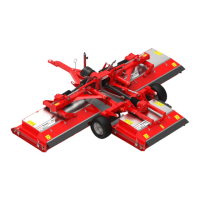TRIMAX SNAKE S2 OPERATORS MANUAL
ENGLISH EDITION
©Trimax Mowing Systems (NZ) Ltd
www.trimaxmowers.com 58 27 March 2019
16i. Wheel & Tyres.
DANGER! Tyre and rim parts can explode if tyres are over-inflated causing
serious injury or death. Always maintain the correct tyre pressure. Do not
inflate the tyres above the recommended pressure.
DANGER! Never weld or heat a wheel and tyre assembly. The heat can
cause an increase in air pressure resulting in a tyre explosion. Welding can
structurally weaken or deform the wheel.
CAUTION! When inflating tyres use a clip-on fitting and extension hose long
enough to allow you to stand to one side and NOT in front of or over the tyre
assembly.
1. Check tyre pressures:
a. Check the road wheel tyre pressures weekly.
b. Tyres should be inflated to the pressures shown in the table. NEVER EXCEED THE
MAXIMUM INFLATION PRESSURE!
c. Inspect the tyres for wear, cuts, cracking, loose or missing stud nuts or other damage. Repair
or replace if necessary.
2. To remove the wheels:
a. Park the mower on level ground.
b. The mower decks can be raised or lowered, with the mower attached to the tractor or on its
own.
c. If the mower is to remain connected to the tractor, engage the parking brake, place all
controls in neutral, stop the engine and remove the ignition key before proceeding further.
d. Chock the wheel not being removed to prevent movement when jacking the other wheel up.
e. Use a suitable jack with a capacity of at
least 1,000kg (1 ton).
f. Place the jack beneath the square steel
tube that houses the suspension and jack the
chassis up to take part of the weight. Do not
lift the wheel clear of the ground at this stage.
g. Use a wheel brace or a 21mm or 13/16”
socket to loosen the wheel nuts. Turn them
anti-clockwise to loosen. Do not remove the
nuts.
h. Jack the wheel clear of the ground.
i. Remove the wheel nuts and the wheel.
DANGER! If the mower must be left jacked up and unattended while the
tyre is being repaired place blocks or a suitable stand beneath the axle.

